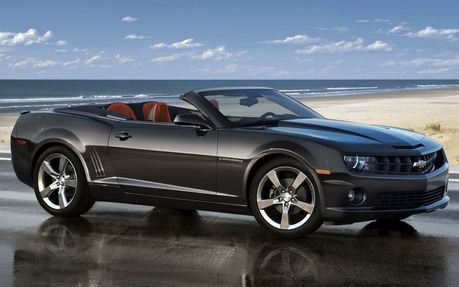Camaro V6 Convertible: Is 6 > 8?
It’s all too easy to gang up on General Motors. In fact, it’s all too easy to gang up on American auto manufacturers in general. In fact, it’s not the crash safety standards, emissions, or consumption legislation that Ford, Chevy, and Dodge fear… it’s the perception they must endure. But cars like this are a doing damn fine work of dispelling those fears. Because although I may have vilified that automatic-equipped SS model I wrote of last week, I found myself falling for the V6, and falling hard. And if you’re anything like I used to be, you’ll find that hard to believe.
Because if there’s one thing that I struggled with, it’s the notion that a Camaro can be just as good, nay, better with the installation of a smaller engine. Displacing just 3.6 litres and now producing an improved 312 horsepower, the smaller of the engines available under the Camaro’s shapely bonnet is a real gem, even if its horsepower increase is a bit of a lie. Having an advertised 304 horsepower just last year, GM’s engineers were happy to report an 8 horsepower increase this year, although further investigation revealed that credit for the increase should rightfully go to the marketing department. Disclosing that last years’ horsepower figure was slightly underrated while this years’ is SAE certified, the car is no faster in reality, but certainly benefits from besting the Mustang V6’s horsepower rating when it comes time to bench race the pair.
However, out on the street, you certainly won’t find yourself wanting for horsepower, with or without any real increase. Running smoothly and seamlessly towards 6,400 revolutions per minute, whereupon its peak horsepower arrives, the engine is every bit as good as that which has been the world’s benchmark V6 for over a decade: Nissan’s VQ-series V6. In fact, it’s nearly identical in both its performance and character; delivering a solid low-end shove courtesy of 278 foot-pounds of torque (the Nissan provides 270) and a heady rush of speed that surprises with its alacrity in the upper reaches of the tachometer’s sweep. Hell, it even sounds nearly the same, eliciting a sonorous sound that’s just a wee bit less refined and slightly more masculine than its Japanese counterpart and, quite obviously, inspiration.
But if there’s one thing that makes the V6 that much better than its V8 sibling, it is its performance in front of a torque converter. Having been developed for the incredibly extensively tested and critically acclaimed Cadillac CTS, the engine and transmission both work amazingly well in concert, and prove that automatic gearboxes have indeed evolved beyond the slow-to-respond slushbox that can be found backing the V8-powered Camaro. Shifting snappily, channeling plenty of power, and forming a much more solid and predictable link between the throttle pedal and the rear tires, the V6’s automatic is one that provokes immature antics and begs to stretch its legs.
And combining these two well-matched mechanical devices within the engine bay of Chevy’s drop-top convertible is a recipe for one incredibly persuasive vehicle. Sounding like a proper, grown-up V6 with as much hair on its chest as such an engine can muster (it still doesn’t sound as good as a proper, manual gearbox-equipped V8), and possessing a decent propensity for oversteer, it’s a properly fun automobile. The steering is sharp and quick, and the nose points into corners with the willingness of an eager puppy. After that, it’s up to you how it goes; hammer on the throttle and start dialing in the opposite lock if you don’t mind paying a ticket or two, or simply roll into it and surf the wave of torque on the way out. Should you affect the latter plan, you might discover that the Camaro’s ability to adhere to the road is surprisingly tenacious, with the rear end rolling out predictably and smoothly when velocity eventually overcomes the tires’ tenacity. And the best part of all? That throughout all this, you get to enjoy the sensory symphony that is the howling of the tires, the snort of the exhaust, the smell of hot, vulcanized rubber and the rush of the passing wind.
And in doing so, you really can come to appreciate that although American cars, and the people that make them, may have struggled through some dark, dark days, they’ve also come ridiculously far in a ridiculously short amount of time. And although there are still those foolish enough to consider the American automotive industry’s products inferior based on nothing more than their place of origin, the rest of us can truly appreciate cars like this, that combine a serious dose of good old American attitude with a helping of modern America’s sensibility.
| Test drive report | |
| Test model | 2011 Chevrolet Camaro |
|---|---|
| Trim level | 2LT Convertible |
| Price range | $29,040 – $45,300 |
| Price as tested | 40 450 $ |
| Warranty (basic) | 3 years/60,000 km |
| Warranty (powertrain) | 5 years/160,000 km |
| Fuel economy (city/highway/observed) | 13,8 / 8,4 / 12,7 L/100km |
| Options | N/A |
| Competitive models | Dodge Challenger, Ford Mustang, Mazda RX-8 |
| Strong points |
|
| Weak points |
|
| Editor's rating | |
| Fuel economy | |
| Value | |
| Styling | |
| Comfort | |
| Performance | |
| Overall | |
